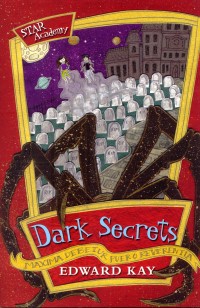| ________________
CM . . . . Volume XVIII Number 19 . . . . January 20, 2012

 |
STAR Academy: Dark Secrets.
Edward Kay.
Toronto, ON: Doubleday Canada, 2011.
288 pp., pbk., $14.95.
ISBN 978-0-385-66707-4.
Grades 5-9 / Ages 10-14.
Review by Ruth McMahon.
*1/2 /4
Reviewed from Uncorrected Pages.
|
| |
|

excerpt:
Snootman continued, “As a scientific ultra-genius myself, I realize the loneliness and isolation that this brings. There are so few people with whom one can truly communicate. I know that the four of you must long for one another’s company, and for projects you can work on together. That’s why you have these video conferences. So I’m willing to fund the best science-education program in the world for the four of you, at a facility of your choosing, on the condition that you immediately devote yourself to learning as much about genetics as possible, with the goal of reversing Eugenia’s condition. If you succeed, I will drop my lawsuit against you.”
... “In addition to our education, [said Amanda] I want the research and development programs for our pet science interests to be fully funded, the way they were at the Academy. That’s my space-travel research, Evelyn’s oceanographic studies, Derek’s satellite and optical projects, and Sanjay’s nanobot development.”
Dark Secrets, the second instalment in the ”Star Academy” series, picks up where the first volume (see CM, Vol. XVI, No. 2) concluded. Mr. Snootman, whose unpleasant daughter Eugenia was transformed by alien DNA in the first book, wants to reunite all the brilliant young people who were students of the STAR (Superior Thinking and Advanced Research) Academy when it was run by aliens who were using the teens’ discoveries in an attempt to take over the earth. Snootman hopes the young people’s creative thinking will generate the process to reverse his daughter’s unfortunate transformation. Using his multi-billions, he reinstates the STAR Academy, bringing back the former students and hiring leading academics to direct the students’ work.
My assessment of this title is very similar to that of the reviewer of first novel in this series who noted the development of the characters to be weak, and this weakness is true of this volume as well. For example, Amanda’s endorsement hungry father; the envious Professor Thorne; and Eugenia’s entourage (Ethyl – as in alcohol, Joules – as in unit of energy and Arsinée – a name which according to one website means “[it] causes an over-emphasis on material things that frustrates higher humanitarian qualities and [its bearer will] want to make money in easier ways than through arduous work,”) who are bribed to be her supporters. George, who was the helpful alien in the previous offering, shows up in this book as a hologram capable of answering virtually all of Amanda’s questions and providing her with the key to the reversal procedure to be used on Eugenia.
I also agree with the previous reviewer’s assessment of the science in this title which “often stretches the limits of credulity.” This is demonstrated in the problem solving hologram; the miraculous surgery (using Sangay’s nanobots) to revert Eugenia to her former human state; and the anti-gravity chamber, to name a few.
The earlier reviewer’s comments on the writing style (“long-winded and educated”) also hold true in this second instalment. In that review, it was stated that this style may be attractive to some “smart kids” which is certainly a possibility, but that is putting a very positive spin on the author’s style. I would go further and say that the writing borders on pedantic in this sequel and that the wordplay is overdone, e.g. Professors Lietsped and Oppenheim, a rapper named Emcee Squared, the reference to binary form (p. 63). The author’s use of sophisticated language matches the super intelligence of the characters, but it does not always mesh with the B movie plotline and will deter some readers. Awkward grammar, for example, “A few minutes and a few large bowls of popcorn later, the four of them sat watching the first of what would become an evening full of films about DNA and how it combines in every human to recreate a being who retains aspects of both her mother and their father, but in a way that forms a totally new person” (p. 132) also interferes with the readability of the title.
In general, I found this offering forced and frenetic, with one dimensional characters and a far-fetched plot. I personally would not spend my library dollars on this title, but for libraries that had success with the first title, they may wish to purchase its sequel.
Not recommended.
Ruth McMahon is a professional librarian working in an Alberta middle school with daughters in middle and elementary school.

To comment
on this title or this review, send mail to cm@umanitoba.ca.
Copyright © the Manitoba Library Association. Reproduction for personal
use is permitted only if this copyright notice is maintained. Any
other reproduction is prohibited without permission.
NEXT REVIEW |
TABLE OF CONTENTS FOR THIS ISSUE
- January 20, 2012.
AUTHORS |
TITLES |
MEDIA REVIEWS |
PROFILES |
BACK ISSUES |
SEARCH |
CMARCHIVE |
HOME |
